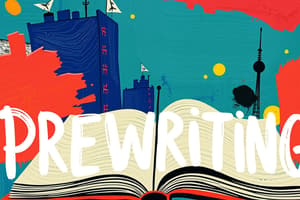Podcast
Questions and Answers
What are the five parts of the writing process?
What are the five parts of the writing process?
Prewriting, drafting, revising, editing, and proofreading.
Which of the following are methods for prewriting? (Select all that apply)
Which of the following are methods for prewriting? (Select all that apply)
- Note taking (correct)
- Clustering (webbing) (correct)
- Proofreading
- Outlining (correct)
What is the difference between drafting, revising, and editing?
What is the difference between drafting, revising, and editing?
Drafting is composing the initial draft; revising rearranges ideas for logic; editing cleans up diction and syntax.
What is proofreading?
What is proofreading?
Flashcards
Writing Process: Parts?
Writing Process: Parts?
The five parts are: prewriting, drafting, revising, editing, and proofreading.
Prewriting methods?
Prewriting methods?
Note taking
Drafting vs. Revising vs. Editing?
Drafting vs. Revising vs. Editing?
Drafting is the initial composition, revising improves the logic and flow, and editing refines the language and grammar.
What is proofreading?
What is proofreading?
Signup and view all the flashcards
Study Notes
Five Steps of the Writing Process
- Prewriting: Initial stage for brainstorming and organizing ideas.
- Drafting: Composing the first version of the writing based on prewriting notes.
- Revising: Rearranging content for clarity and coherence; adding or deleting ideas.
- Editing: Refining word choice and sentence structure for improved clarity.
- Proofreading: Final review for grammar and punctuation errors to ensure accuracy.
Prewriting Methods
- Clustering/Webbing: Visual representation connecting ideas to a central theme.
- Outlining: Structured format listing main ideas with Roman numerals and supporting details using letters and numbers.
- Note Taking: Flexible method encompassing lists, freewriting, mapping, charting, and bulleting to capture and organize thoughts.
Differences Between Drafting, Revising, and Editing
- Drafting focuses on creating a rough version without concern for mistakes.
- Revising improves the draft by reorganizing and enhancing the logical flow of ideas.
- Editing is the process of correcting language issues and ensuring sentence structure is clear and effective.
Proofreading
- Involves the final inspection of the text for typos, punctuation, and overall accuracy to ensure a polished finished product.
Studying That Suits You
Use AI to generate personalized quizzes and flashcards to suit your learning preferences.




